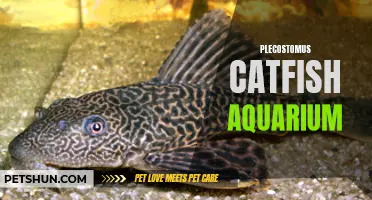
Honey comb catfish, also known as the pleco fish, are fascinating creatures that make for unique and stunning additions to any aquarium. These catfish are characterized by their distinctive honeycomb-like pattern on their body, which adds to their allure. However, caring for these catfish species requires specific attention and understanding due to their specific dietary and habitat needs. In this article, we will delve into the essential aspects of honey comb catfish care, providing you with valuable insights and tips to ensure the well-being and longevity of your aquatic companion. So, whether you are a seasoned fish enthusiast or a beginner looking to explore the world of ornamental catfish, read on to discover all you need to know about honey comb catfish care.
What You'll Learn
- What is the ideal water temperature for honeycomb catfish?
- How often should honeycomb catfish be fed and what should their diet consist of?
- Are there any specific tank requirements for honeycomb catfish?
- How often should water changes be done for honeycomb catfish tanks?
- Are honeycomb catfish compatible with other fish species in a community tank?

What is the ideal water temperature for honeycomb catfish?
Honeycomb catfish, scientifically known as Centromochlus perugiae, are native to the Amazon River basin in South America. These unique catfish are named for their distinctive honeycomb-like pattern on their bodies. Honeycomb catfish are small and peaceful freshwater fish typically kept in home aquariums. Like any other fish, they require specific environmental conditions to thrive, including water temperature.
The ideal water temperature for honeycomb catfish ranges from 72°F (22°C) to 78°F (25.5°C). This temperature range closely mimics the conditions of their natural habitat in the Amazon River, which is warm and tropical. It is important to maintain a stable water temperature within this range to ensure the health and well-being of the honeycomb catfish.
To achieve and maintain the ideal water temperature for honeycomb catfish, there are a few key steps to follow:
- Use a reliable aquarium thermometer: It is crucial to have an accurate and reliable thermometer to monitor the water temperature in the aquarium. Place the thermometer near the catfish's hiding spots or in a central location in the tank for an accurate reading.
- Choose an appropriate aquarium heater: An aquarium heater is essential for maintaining the desired water temperature. Select a heater that is suitable for the size of your aquarium and can accurately maintain the desired temperature range. It is recommended to choose a heater with a built-in thermostat for easy temperature adjustment.
- Properly position the heater: Install the heater in a location where there is good water circulation and where it can distribute heat evenly throughout the tank. Avoid placing the heater near filters or other equipment that may obstruct water flow.
- Monitor the water temperature regularly: Check the water temperature daily using the aquarium thermometer. Make adjustments to the heater as needed to ensure the water remains within the ideal temperature range. Sudden changes in temperature can be stressful for honeycomb catfish, so it is important to monitor and maintain a stable temperature.
It is worth noting that different species of catfish may have distinct temperature preferences. Therefore, it is crucial to research the specific needs of honeycomb catfish before introducing them to an aquarium. Additionally, keep in mind that water quality, filtration, and oxygen levels also play a vital role in the overall health of honeycomb catfish.
In conclusion, maintaining the ideal water temperature for honeycomb catfish is crucial for their health and well-being. By following the steps outlined above and providing a stable temperature within the recommended range, you can create a suitable habitat for these fascinating and unique catfish in your home aquarium.
The Ultimate Guide to Asian Red Tail Catfish Care: Everything You Need to Know
You may want to see also

How often should honeycomb catfish be fed and what should their diet consist of?
Honeycomb catfish, also known as hoplosternum thoracatum, are a popular freshwater aquarium fish. They are native to South America and are known for their distinct appearance and peaceful nature. Like all fish, proper nutrition is essential for the health and well-being of honeycomb catfish. In this article, we will discuss how often honeycomb catfish should be fed and what their diet should consist of.
Honeycomb catfish are omnivorous, which means they can eat both plant and animal matter. In the wild, they primarily feed on insects, worms, small crustaceans, and plant material. It is important to mimic their natural diet as closely as possible when feeding them in captivity.
In terms of frequency, honeycomb catfish should be fed small amounts multiple times a day. This is because they have a small stomach capacity and high metabolic rate. Feeding them small portions throughout the day ensures that they digest their food properly and receive the nutrition they need.
When it comes to their diet, honeycomb catfish can be fed a variety of commercially available fish foods. High-quality pellets, flakes, and frozen foods are all suitable options. It is recommended to rotate between different types of food to provide a balanced diet and prevent nutritional deficiencies. You can also supplement their diet with live or frozen foods such as bloodworms, brine shrimp, and daphnia for added variety.
In addition to commercially available fish foods, honeycomb catfish also enjoy eating fresh vegetables. You can offer them blanched vegetables such as zucchini, spinach, and peas. These vegetables provide additional nutrients and fiber that are beneficial for their digestive system.
It is important to note that overfeeding honeycomb catfish can lead to various health issues, such as obesity and poor water quality. It is better to underfeed them slightly than to overfeed them. Observe their feeding behavior and adjust the amount of food accordingly. Remember, they have small stomachs, so it is better to feed them small portions more frequently rather than one large meal.
In conclusion, honeycomb catfish should be fed small amounts multiple times a day to ensure proper digestion and nutrition. Their diet should consist of high-quality commercial fish foods, supplemented with live or frozen foods and fresh vegetables. By providing a varied and balanced diet, you can ensure the health and longevity of your honeycomb catfish. Remember to observe their feeding behavior and adjust the amount of food accordingly to prevent overfeeding and maintain water quality in their aquarium.
Understanding the Proper Care and Maintenance for Flathead Catfish
You may want to see also

Are there any specific tank requirements for honeycomb catfish?
Honeycomb catfish, also known as Auchenipterichthys coracoideus, are small freshwater catfish native to South America. They are popular among fish enthusiasts for their unique honeycomb pattern on their bodies. If you have recently acquired honeycomb catfish or are considering adding them to your aquarium, it is important to provide them with the proper tank requirements to ensure their well-being. Here are some specific tank requirements that should be met for honeycomb catfish.
Tank size: Honeycomb catfish are relatively small in size, reaching a maximum length of around 4-5 inches. However, they are active swimmers and need plenty of swimming space. A minimum tank size of 20 gallons is recommended for a small group of honeycomb catfish.
Water parameters: Honeycomb catfish are adaptable to a wide range of water conditions. However, it is important to maintain stable and optimal water parameters for their health. The temperature should be kept between 72-78 degrees Fahrenheit (22-25 degrees Celsius). The pH should range from 6.5-7.5, and the water hardness should be around 5-15 dGH.
Filtration and water flow: Honeycomb catfish prefer well-oxygenated water with moderate water flow. A good filtration system should be in place to maintain water quality and prevent the buildup of waste. Consider using a sponge filter or a canister filter to provide adequate filtration for the tank.
Substrate: Honeycomb catfish are bottom dwellers and spend most of their time on the substrate. A soft and sandy substrate is ideal for them, as it mimics their natural habitat. Avoid using sharp gravel, as it can injure their delicate barbels. The substrate should also be kept clean to prevent the accumulation of waste.
Decorations and hiding places: Honeycomb catfish are nocturnal and appreciate the presence of hiding places in the tank. Provide them with caves, driftwood, and plants to create cover and mimic their natural environment. Live plants, such as Java fern and Anubias, can also help maintain water quality and provide additional hiding spots.
Tankmates: Honeycomb catfish are generally peaceful and can be kept with other peaceful community fish. However, they may become aggressive towards smaller tankmates or fish with long, flowing fins. Avoid keeping them with aggressive fish or fin-nipping species. Good tankmates for honeycomb catfish include tetras, rasboras, and small corydoras catfish.
Feeding: Honeycomb catfish are omnivorous and will readily accept a variety of foods. Offer them a balanced diet consisting of high-quality pellets, flakes, frozen or live foods, such as bloodworms and brine shrimp. It is important to feed them small, frequent meals to prevent overeating and ensure their nutritional needs are met.
In conclusion, providing the proper tank requirements for honeycomb catfish is essential for their well-being. Ensure they have enough swimming space, maintain stable water parameters, use appropriate filtration, provide a soft substrate, and create hiding places in the tank. Choose compatible tankmates and offer them a varied diet to keep them healthy and vibrant. By meeting these requirements, you can enjoy the beauty of honeycomb catfish in your aquarium for many years to come.
The Ultimate Guide to Clown Catfish Care: Tips and Essentials
You may want to see also

How often should water changes be done for honeycomb catfish tanks?
Honeycomb catfish, also known as Auchenipterus osteomystax, are popular additions to freshwater aquariums. These catfish have a unique appearance with their dark, honeycomb-like markings on their bodies, hence their name. They are known for their peaceful nature and can be kept with a variety of other fish species.
One crucial aspect of maintaining a healthy honeycomb catfish tank is performing regular water changes. Water changes are necessary to remove accumulated waste, excess nutrients, and other contaminants that can be harmful to the fish. They also help maintain stable water parameters, such as pH and temperature, which are essential for the well-being of the catfish.
So, how often should water changes be done for honeycomb catfish tanks? The frequency of water changes depends on various factors, including tank size, the number of fish, feeding routine, filtration system, and water quality.
In smaller tanks (less than 30 gallons), it is generally recommended to perform partial water changes of about 20% every one to two weeks. This frequency helps maintain a healthy and stable environment for the catfish, especially when combined with regular maintenance practices like gravel vacuuming and filter cleaning.
For larger tanks (30 gallons and above), the water change frequency can be adjusted accordingly. Some aquarists prefer doing smaller water changes more frequently (e.g., 10% every week), while others opt for larger, less frequent changes (e.g., 30% every two weeks). The key is to find a balance that works well for the specific tank and the fish inhabitants.
When it comes to feeding, honeycomb catfish are not particularly demanding and can thrive on a varied diet of high-quality commercial fish foods, frozen or live foods, and occasional vegetable matter. However, overfeeding can lead to excessive waste production and water quality issues. Therefore, it is essential to monitor the feeding habits and adjust the water change frequency accordingly.
The efficiency of the filtration system is another factor that affects the frequency of water changes. A well-maintained filter plays a crucial role in removing physical and chemical pollutants from the water. However, even the best filter cannot remove all the waste and toxins. Therefore, regular water changes are still necessary.
In addition to regular water changes, it is essential to test the water parameters regularly to ensure they are within the appropriate range for honeycomb catfish. Parameters such as ammonia, nitrite, nitrate, pH, and temperature should be monitored and adjusted as needed. A water testing kit can provide accurate readings and help determine the timing and frequency of water changes.
It is also worth mentioning that water changes alone are not sufficient to maintain a healthy tank. Basic aquarium maintenance practices, such as removing uneaten food, keeping the tank clean, trimming plants, and providing adequate hiding places and decorations, should be performed regularly. These practices help promote a healthy and stress-free environment for the honeycomb catfish and other tank inhabitants.
To summarize, water changes are an essential aspect of maintaining a healthy honeycomb catfish tank. The frequency of water changes depends on factors such as tank size, the number of fish, feeding routine, filtration system, and water quality. Regular testing of water parameters and monitoring the behavior and health of the catfish can help determine the optimal water change schedule. By adhering to a consistent water change routine and implementing proper tank maintenance practices, aquarists can provide a thriving and enjoyable environment for their honeycomb catfish.
The Ultimate Guide to Berney's Catfish Care: Tips and Tricks for a Happy and Healthy Fish
You may want to see also

Are honeycomb catfish compatible with other fish species in a community tank?
When setting up a community tank, one of the key factors to consider is the compatibility of different fish species. This is particularly important when it comes to catfish, as they can have specific requirements and behaviors that may clash with those of other fish. In this article, we will explore whether honeycomb catfish (Centromochlus perugiae) are compatible with other fish species in a community tank.
Honeycomb catfish, also known as honeycomb woodcats or honeycomb armoured catfish, are freshwater catfish native to South America. They are unique in appearance, with a honeycomb-like pattern on their body and long, flowing fins. These catfish are relatively small, usually reaching a maximum size of around 3 inches.
In terms of compatibility, honeycomb catfish are generally considered to be peaceful and non-aggressive towards other fish. They are not known to be fin nippers, making them a suitable choice for a community tank. However, there are a few factors to consider when keeping honeycomb catfish with other fish species.
Firstly, it is important to ensure that the tank size is suitable for the number and size of fish. Honeycomb catfish are relatively small, so a tank of at least 20 gallons should be sufficient. However, larger tanks with plenty of hiding spots and territories are always preferable, as they allow all fish to establish their own space and reduce stress.
Secondly, honeycomb catfish are nocturnal creatures, which means they are most active during the night. This can be problematic if they are housed with diurnal (daytime-active) fish species, as the catfish may become stressed and hide during the day. To avoid this, it is best to choose tankmates that are also nocturnal or at least do not have significantly conflicting activity patterns.
When selecting tankmates for honeycomb catfish, it is important to choose fish species that have similar water requirements. Honeycomb catfish prefer soft and slightly acidic water conditions, with a pH range of 6.0-7.5 and a temperature range of 75-82°F. Therefore, it is best to avoid fish species that require drastically different water parameters, as this can lead to stress and health issues for both the catfish and the other fish.
Some potential tankmates for honeycomb catfish include other small, peaceful fish species that also prefer similar water conditions. For example, tetras, rasboras, and small Corydoras catfish can make good companions for honeycomb catfish. These species are all relatively small, peaceful, and have similar activity patterns, making them suitable tankmates.
In conclusion, honeycomb catfish can indeed be compatible with other fish species in a community tank, provided that certain factors are considered. Tank size, activity patterns, and water requirements are crucial factors to ensure the well-being of all fish in the tank. By selecting appropriate tankmates and maintaining suitable water conditions, a harmonious community tank can be created with honeycomb catfish as part of the ensemble.
The Complete Guide to African Bumblebee Catfish Care
You may want to see also
Frequently asked questions
Honeycomb catfish are omnivorous and should be fed a mix of both meaty and plant-based foods. It is recommended to feed them small amounts multiple times throughout the day rather than one large meal. You can feed them a variety of foods such as bloodworms, brine shrimp, sinking pellets, and blanched vegetables. Aim to feed them 2-3 times a day, making sure to remove any uneaten food after a few minutes to prevent water quality issues.
Honeycomb catfish are bottom dwellers and prefer a well-decorated tank with plenty of hiding spots such as caves, rocks, and driftwood. They also appreciate a sandy substrate to sift through in search of food. The tank should be spacious enough to accommodate their natural behaviors and provide enough swimming space. The water temperature should be kept between 72-78°F (22-26°C) with a pH range of 6.5-7.5. Regular water changes should be performed to maintain good water quality.
Honeycomb catfish are generally peaceful and can be housed with a variety of other peaceful fish species. However, they should not be kept with aggressive or overly boisterous fish that may intimidate or harm them. Good tankmates for honeycomb catfish include small to medium-sized community fish such as tetras, rasboras, corydoras catfish, and peaceful cichlids. It is also important to consider the size of the tank and provide enough hiding spots and territories to prevent aggression or competition for resources. Monitoring the behavior of tankmates and ensuring they are compatible is crucial for the well-being of all fish in the tank.







